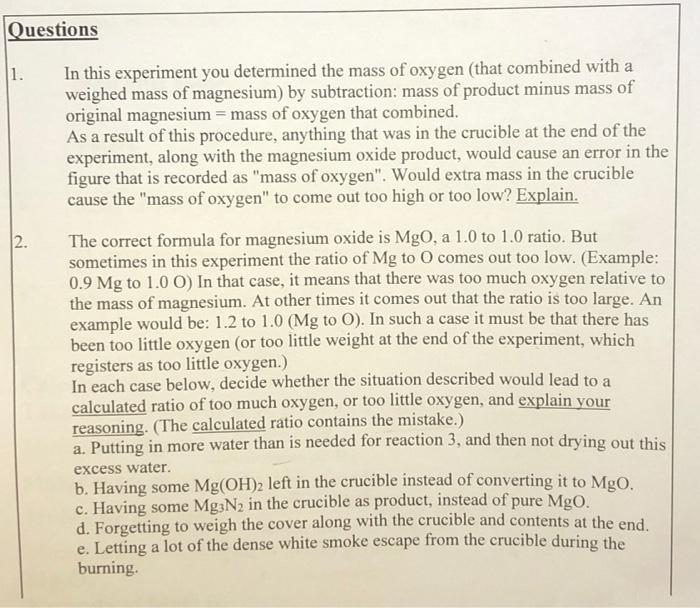Answered step by step
Verified Expert Solution
Question
1 Approved Answer
Questions 1. 2. In this experiment you determined the mass of oxygen (that combined with a weighed mass of magnesium) by subtraction: mass of

Questions 1. 2. In this experiment you determined the mass of oxygen (that combined with a weighed mass of magnesium) by subtraction: mass of product minus mass of original magnesium = mass of oxygen that combined. As a result of this procedure, anything that was in the crucible at the end of the experiment, along with the magnesium oxide product, would cause an error in the figure that is recorded as "mass of oxygen". Would extra mass in the crucible cause the "mass of oxygen" to come out too high or too low? Explain. The correct formula for magnesium oxide is MgO, a 1.0 to 1.0 ratio. But sometimes in this experiment the ratio of Mg to O comes out too low. (Example: 0.9 Mg to 1.0 O) In that case, it means that there was too much oxygen relative to the mass of magnesium. At other times it comes out that the ratio is too large. An example would be: 1.2 to 1.0 (Mg to O). In such a case it must be that there has been too little oxygen (or too little weight at the end of the experiment, which registers as too little oxygen.) In each case below, decide whether the situation described would lead to a calculated ratio of too much oxygen, or too little oxygen, and explain your reasoning. (The calculated ratio contains the mistake.) a. Putting in more water than is needed for reaction 3, and then not drying out this excess water. b. Having some Mg(OH)2 left in the crucible instead of converting it to MgO. c. Having some Mg3N2 in the crucible as product, instead of pure MgO. d. Forgetting to weigh the cover along with the crucible and contents at the end. e. Letting a lot of the dense white smoke escape from the crucible during the burning.
Step by Step Solution
There are 3 Steps involved in it
Step: 1

Get Instant Access to Expert-Tailored Solutions
See step-by-step solutions with expert insights and AI powered tools for academic success
Step: 2

Step: 3

Ace Your Homework with AI
Get the answers you need in no time with our AI-driven, step-by-step assistance
Get Started


